Adventurous Kate contains affiliate links. If you make a purchase through these links, I will earn a commission at no extra cost to you. Thanks!
San Pedro de Atacama is a small-town oasis surrounded by one of the driest places on the planet. People come from around the world to experience the Atacama Desert, and there are plenty of fun things to do in San Pedro de Atacama, the gateway to exploring this otherworldly setting.
Planning your trip to San Pedro de Atacama last minute?
San Pedro is a small town and most popular tours and hotels book up fast. Book ahead to avoid disappointment!
🔭 Top Experiences and Tours in San Pedro de Atacama:
- Stargazing Tour with an Astronomer (Absolute must!)
- Puritama Hot Springs (My favorite thing I did!)
- El Tatio Geysers Tour (Better on a tour than on your own)
🛌 Top-Rated Hotels in San Pedro de Atacama:
- Casa Lickana B&B (I stayed here and loved it!)
- Hotel Desertica (Upscale + great location)
- La Casa del Pueblo Hostal (Great budget option)
🚗 Renting a car from Calama Airport near San Pedro? Find deals on car rental rates here.
My husband Charlie and I chose to visit Atacama Desert on our monthlong Chile-Argentina-Uruguay honeymoon. Why? Volcanoes, salty lakes, erupting geysers, giant sand dunes, and bizarre rock formations — not to mention the flamingos, guanacos, and vicuñas!
Right away, we knew San Pedro de Atacama would be the best base for exploring the Atacama Desert in Chile. A small town with a bohemian feel, sitting at 2,400 meters above sea level and surrounded by the Andes mountains, San Pedro is full of character (and characters) — a fun place to return after exploring the desert each day!
Here are the best things to do in San Pedro de Atacama — gateway to some of the most visually striking places in Chile, a country that punches above its weight in terms of natural beauty.
This post was published in February 2024 and was co-written by Adventurous Kate and Hannah Cooper.
Table of Contents
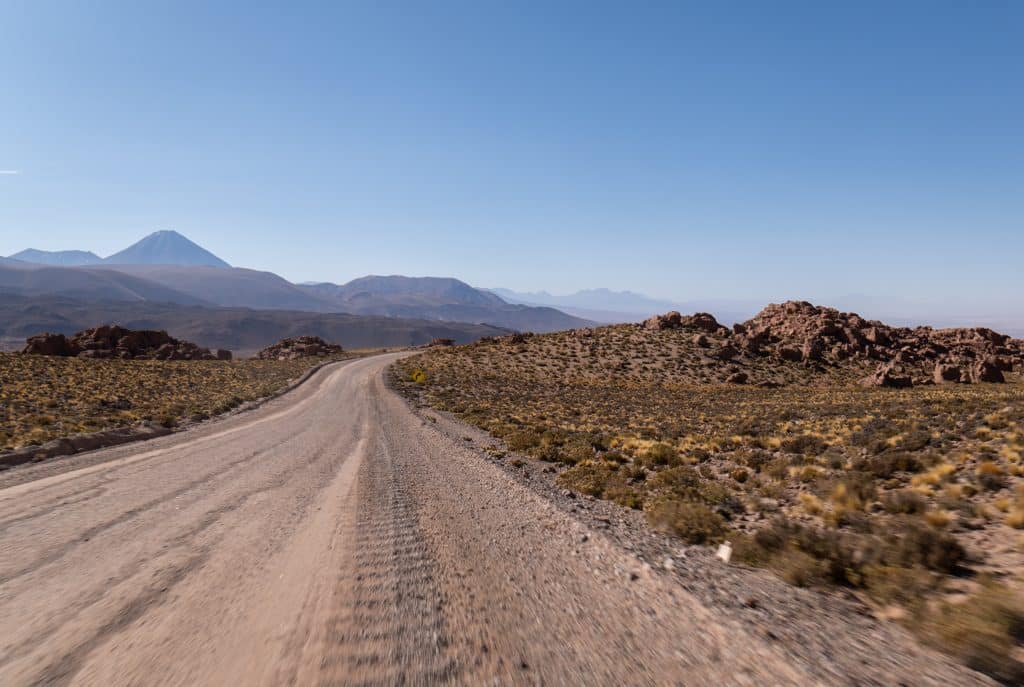
Safety in San Pedro de Atacama
Please don’t skip this section, it’s important!! I’m adding in a section on safety in San Pedro de Atacama because I feel like the dangers of the desert are so underplayed.
First off, the Atacama Desert is a high-altitude desert, which is a tough on your body. You’ll be experiencing the effects of a desert climate (dry eyes, nose, lips, and skin) as well as possibly the effects of altitude (fatigue, dizziness, headaches), especially in highest-altitude places like the El Tatio geysers.
Secondly, you need to decide whether to 1) rent a car and explore independently, or 2) book tours. Charlie and I rented a car, but knowing what I know now about the driving conditions, booking tours is far safer.
There is only one gas station in the area — in the town of San Pedro de Atacama — and if you break down, your situation could quickly turn deadly. There is no phone signal outside the town. Many roads are unpaved and in bad condition. It is incredibly hot during the day and quite cold at night. There are safety trucks patrolling the most traversed roads, and they often have to save stranded tourists.
At one point we realized we had a deflating tire that had to be inflated each morning, and my heart was in my throat until we got back to Calama Airport safely.
If you’re driving on your own, check your tire pressure, keep a full tank of gas, and take water and food with you. Don’t drive on your own if you’re traveling solo. Don’t drive while tired. Drive slowly, take no chances, and keep an eye out for wildlife.
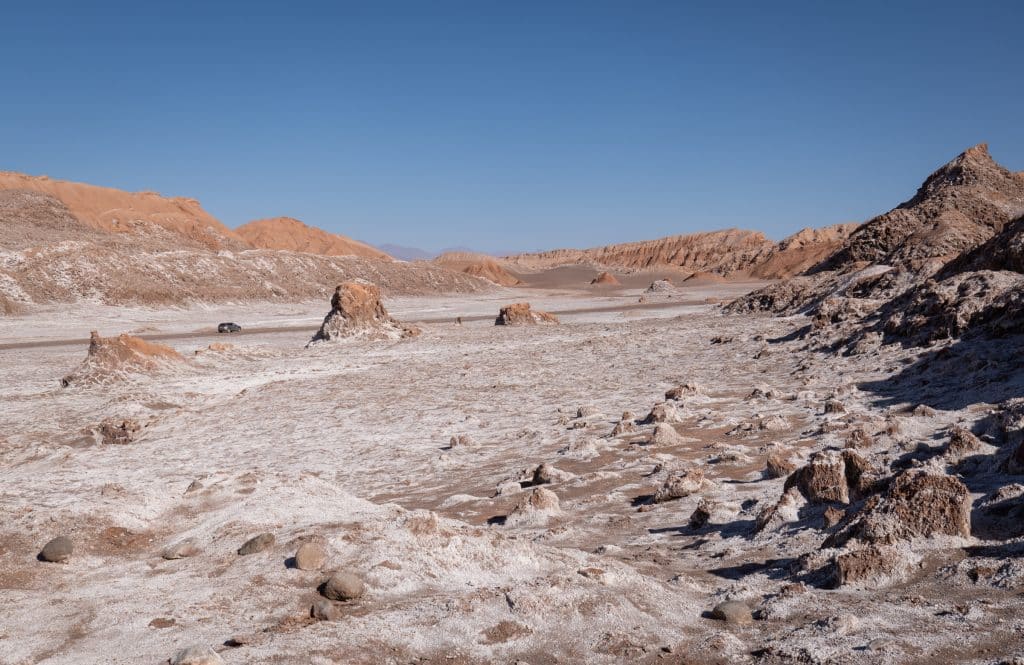
Best Things to Do in San Pedro de Atacama
Visit the Valle de la Luna
Valle de la Luna (Moon Valley) is one of the most popular attractions in the Atacama, and I think it’s a good place to visit on your first day in San Pedro de Atacama, as it’s a good afternoon destination. The main activities here include the mysterious Three Marias rocks, an abandoned salt mine, and a 40-minute walk through the colossal dunes.
Valle de la Luna is an easy 25-minute drive from San Pedro (which you will soon learn is EXTREMELY close by Atacama standards). Many tourists cycle there, although you must arrive before 11:00 AM.
Instead, I recommend arriving in the afternoon when the light is softer, and then hanging around for sunset at the La Piedra del Coyote viewpoint. You should buy admission tickets via Punto Ticket — you will need to arrive at a specific time.
Otherwise, you can book a Valle de la Luna tour from San Pedro. This tour brings you to the sites listed and concludes with watching the sunset nearby.
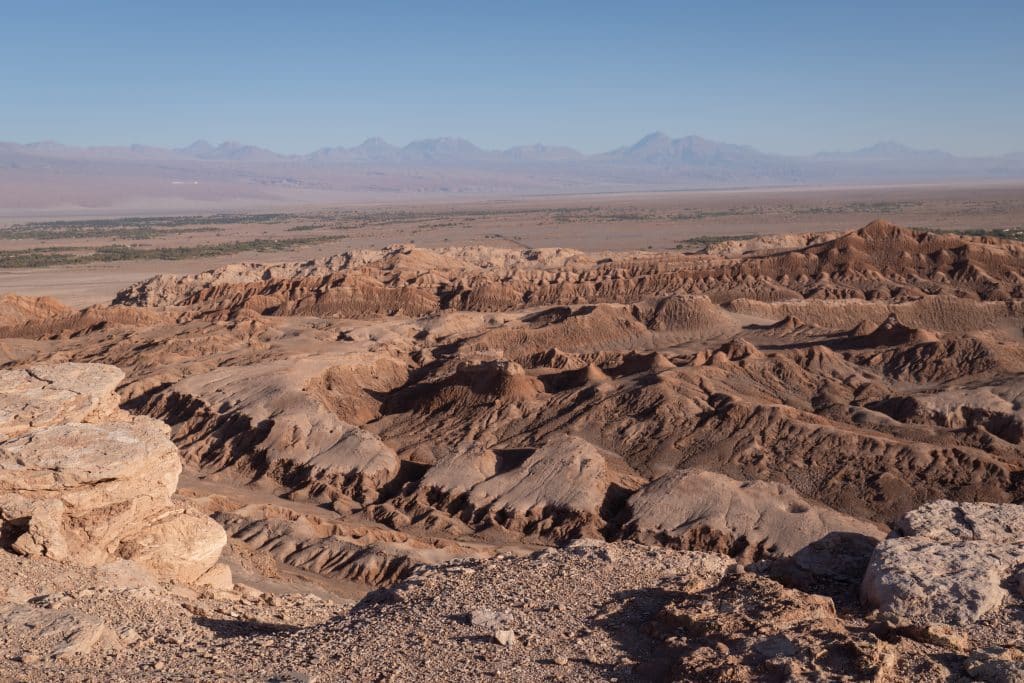
Watch the sunset at La Piedra del Coyote
La Piedra del Coyote (aka Mirador de Kari) is one of the best places to see the sunset in the Atacama. This is one of the most popular photos of the Atacama, and one that you’ve likely already seen: a huge plateau overlooking the Valle de la Luna where the jagged rocks and the Andes mountains light up in different colors as the sun sinks into the horizon.
Note that admission to this point is only possible with a Valle de la Luna ticket and must be on the same day; you can’t visit otherwise. Also, you should know that there isn’t really anywhere comfortable to sit here; there are a few cement blocks you can sit on, but they might all be taken, leaving you to pick out a rock.
Once the sunset wraps, the staff will shoo you out. That’s around 8:30 PM in summer and 5:30 PM in winter.
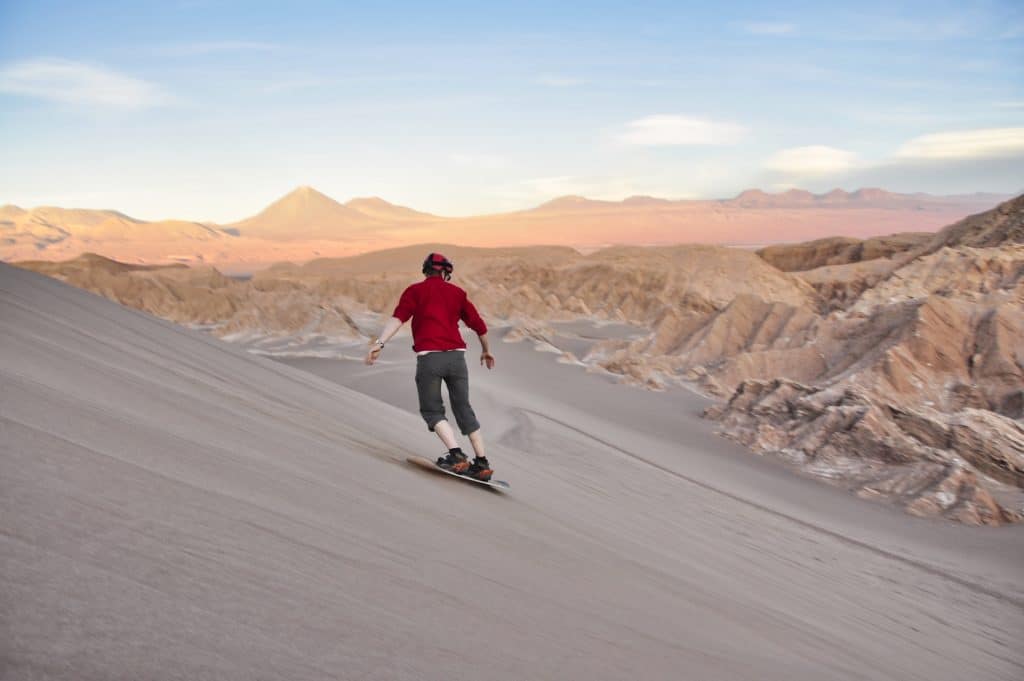
Go sandboarding in the Valle de la Muerte
Sandboarding in Valle de la Muerte (the Atacama’s Death Valley) is one of the most adventurous things to do in San Pedro de Atacama! This valley is only five minutes from town and features dunes ranging from 40 meters to 200 meters.
Valle de la Muerte reopened for sandboarding in 2023 after being shut down. Sandboard San Pedro is one of the best tour operators offering equipment, guides bilingual in Spanish and English, and transport. They run morning, afternoon, and full-moon sandboarding tours.
Note that this region is sometimes referred to as Valle de Marte (Mars Valley).
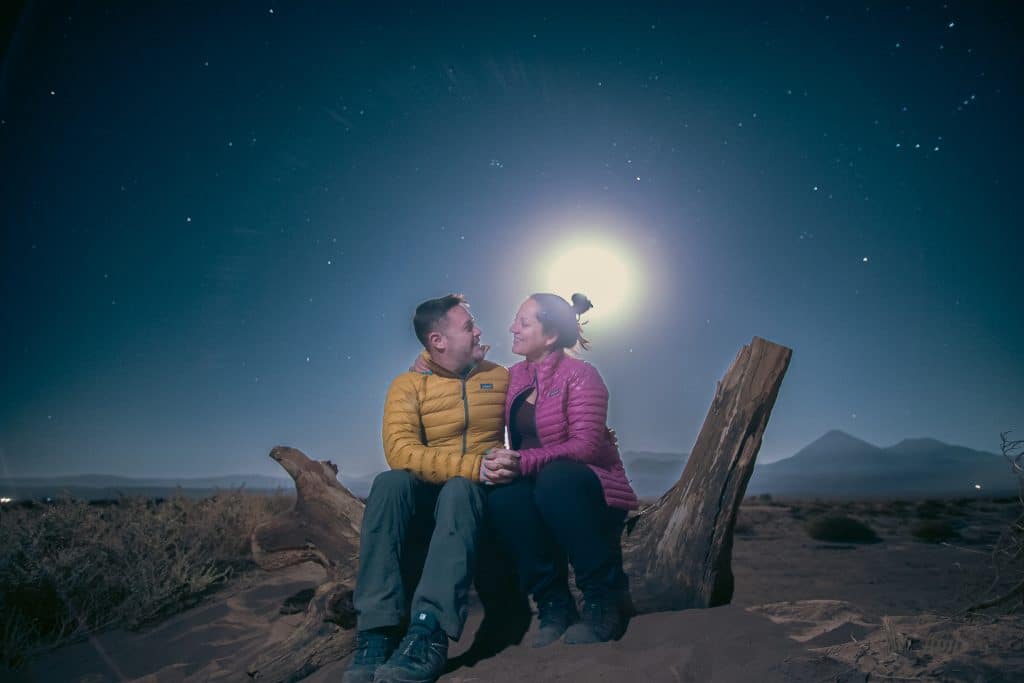
Go stargazing
Did you know that the Atacama Desert is home to the best stargazing on the planet? Seriously! The bone-dry, high-altitude climate allows exceptional visibility.
Astronomical tours are one of the best things to do in San Pedro de Atacama, and allow you to learn about astronomy and view celestial objects through a telescope.
Tours generally cost around $40-45 USD and include a professional astrophoto, like the one you see above. A few options worth checking out are this stargazing tour with an astronomer (the cheapest small-group tour), this astronomical and astrophotography tour (with more emphasis on photographing the stars) and the premium “Under the Atacama Night” (with a cultural focus).
However, don’t make the mistake I did — don’t book a trip to the Atacama during the full moon if you can help it! The light from the moon wipes out the stars. It was a clear night and we were still able to see some stars (as well as Jupiter and Saturn, both very cool), but a night with the new moon would have been infinitely better.
Star-gazing can be done year-round in San Pedro de Atacama. You should know that clouds are rare in the Atacama but tour-canceling cloudy skies are most common in the months of January and February. The Milky Way is visible during the winter months (June, July, and August).
It used to be possible to visit the ALMA Observatory, however, public visits are currently suspended.
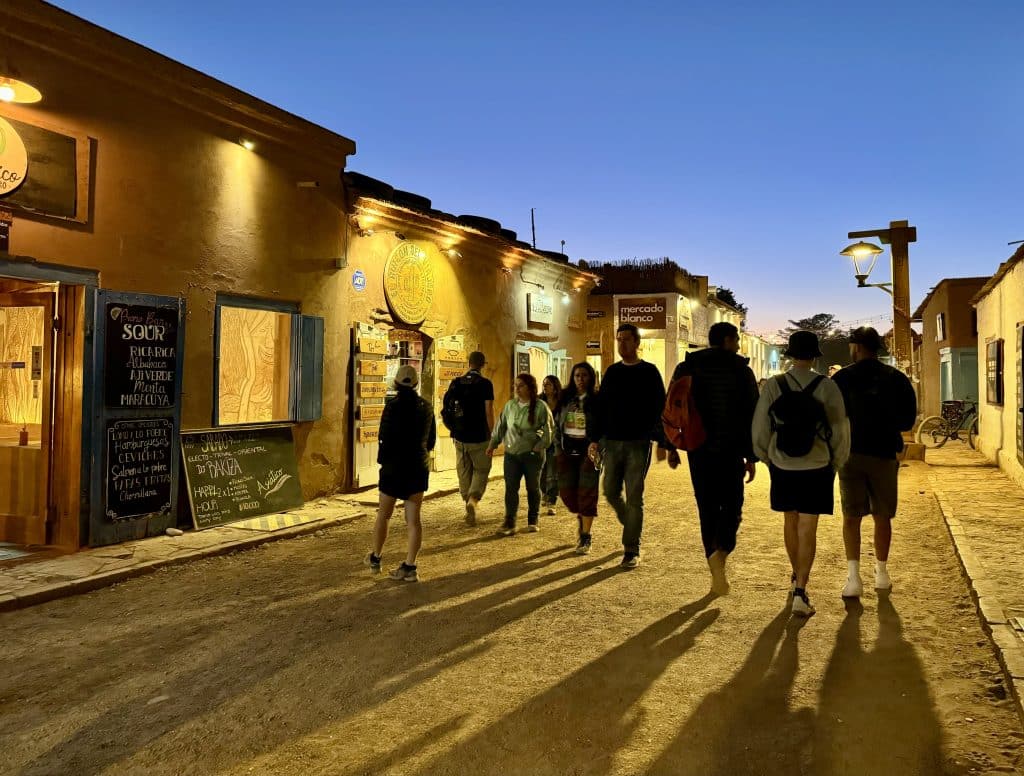
Explore the town of San Pedro de Atacama
The town of San Pedro de Atacama is as touristy as it comes — but that’s a good thing here! The town has a bohemian, hippie feel, and reminds me a lot of places like Pai, Thailand, and Holbox, Mexico. You’ll find a smattering of good restaurants, tons of tour companies, souvenir shops galore, bike rental companies, and impromptu pan flute jams.
Pedestrian-only Caracoles is the central walking street in San Pedro, and it’s especially pleasant around sunset, when the fierce daytime temperatures drop and everyone comes out to stroll. It’s like the passeggiata in Italy!
Here are a few of my favorite spots in San Pedro de Atacama:
ChelaCabur — This bar has a fun atmosphere, a big beer list, offbeat decor, and great music. Oddly, I felt at home right away! Their chelada — a light beer with lime juice, ice, and salt — hits the spot after a day in the desert, replacing all the electrolytes you’ve lost.
Roots Café & Bar — This alternative cafe boasts the best coffee in town. It also felt like the coolest people in town happened to be working here! Charlie and I each ordered an iced coffee on a hot day – followed swiftly by a second iced coffee. They were that good.
Emporio Andino — This bakery serves fantastic empanadas and they’re big enough to have one as a meal. So good that we had them for dinner on multiple occasions! I especially loved their caprese empanada with queso mantecoso, tomato, and basil.
Heladería Babalú — Visiting this beloved ice cream shop in San Pedro is practically a rite of passage! Here you can find both classic flavors and some unusual options inspired by the local herbs, like “flor del desierto” and “rica-rica.” My favorite was the maracuya (passion fruit).
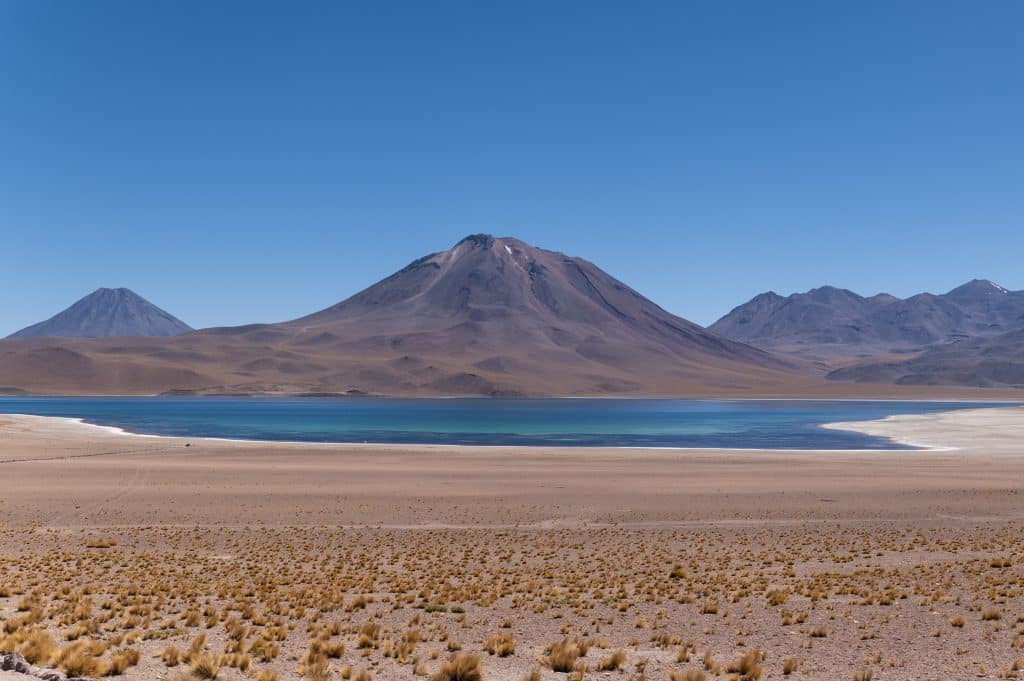
Visit the stunning Lagunas Altiplánicas
Sitting at maximum altitudes of 4,100 meters, the cobalt-blue Lagunas Altiplánicas are individually called Miscanti and Miñiques. These sparkling lakes are linked by a walking trail designed for landscape photography and birdwatching, and I was impressed by their beauty.
If you’re planning to visit Lagunas Altiplánicas independently, you will need to buy timed tickets via the Socaire website. I strongly recommend buying the ticket package that includes both the Lagunas Altiplánicas and Piedras Rojas, as they’re close to each other.
Socaire is about an hour’s drive from San Pedro, so factor this into choosing your time slot. You’ll have to check in at the town of Socaire on the way and collect a paper ticket. Officially, check-in is one hour before your timestamp. We arrived a bit early and it wasn’t an issue, but it’s wise to stick to the time slot.
We had a lot of issues with the site timing out when trying to buy the tickets. It was like pulling teeth. Overall, I recommend going with a tour for this activity rather than going on your own.
This top-rated tour takes you to Piedras Rojas, the Altiplanic Lagoons, and Salar de Atacama. If you book a tour, the entrance fee must be paid separately in Chilean pesos; your guides will collect the fee on the drive.
Another bonus: the turn-off to the dirt road leading to Lagunas Altiplánicas has lots of vicuñas, a llama-like creature! We saw a whole family.
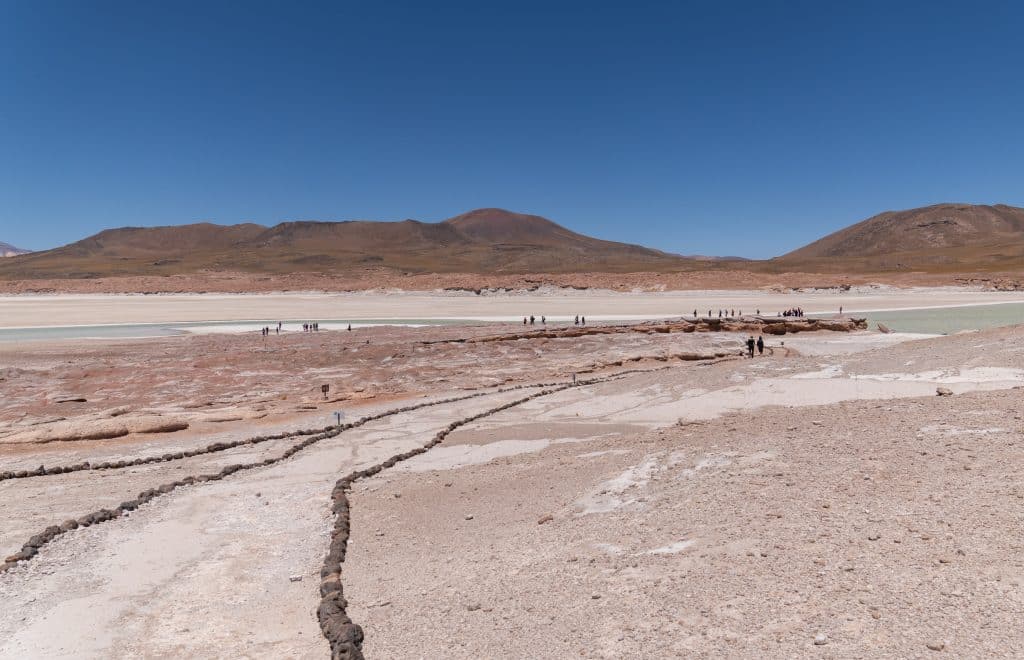
Walk around Las Piedras Rojas
After leaving the Lagunas Altiplánicas, the Piedras Rojas (Red Rocks) are a 45-minute drive further south. Also known as the Aguas Calientes Salt Flat, these rust-colored boulders edge another high-altitude salt lake. The pale blues and greens of the water with the deep pink and red hues of the rocks lead to an otherworldly atmosphere.
There is an easy, mostly flat walking trail taking you around the salt lakes. But you should know that you’re at 3,800 meters above sea level — expect to be a bit out of breath when doing this walk. Dress warmly, as it will be chilly and windy. I was wearing a denim jacket, which wasn’t quite warm enough for this area. My Uniqlo ultra light down jacket would have been a better choice.
The guides said that the walking trail would take around 90 minutes; Charlie and I walked it quickly and did it in 40 minutes.
If you want to visit Piedras Rojas on a tour, I recommend the same Piedras Rojas, the Altiplanic Lagoons, and Salar de Atacama tour listed above.
Note: if traveling independently, by this time you’ll probably be ready for lunch. There are a few places to eat in Socaire.
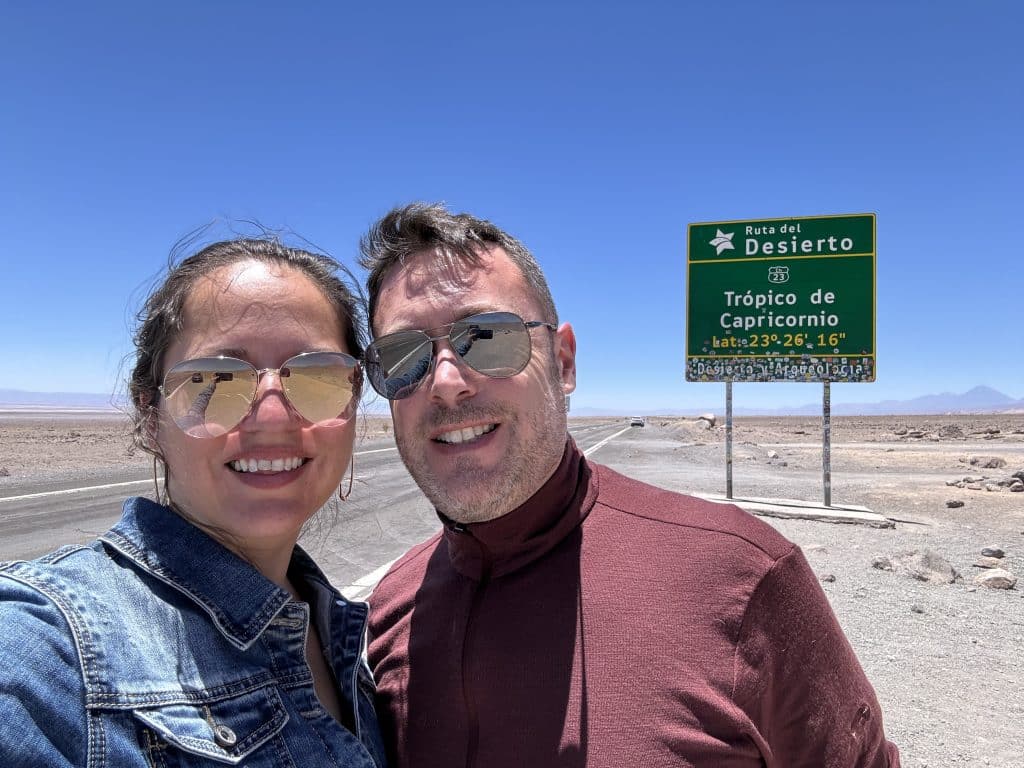
Pose at the Tropic of Capricorn Sign
The Tropic of Capricorn is located just south of San Pedro de Atacama, and there is an Instagram-ready sign marking it! You can find Tropic of Capricorn signs on either side of Highway 23, about 45 minutes’ driving time south of San Pedro de Atacama, just north of Socaire.
There’s nothing else to do here — but it’s definitely worth stopping for a quick photo on your way to or from the Lagunas Altiplánicos and the Piedras Rojas.
This wasn’t my first time at the Tropic of Capricorn — I also drove through it near Shark Bay in Western Australia.
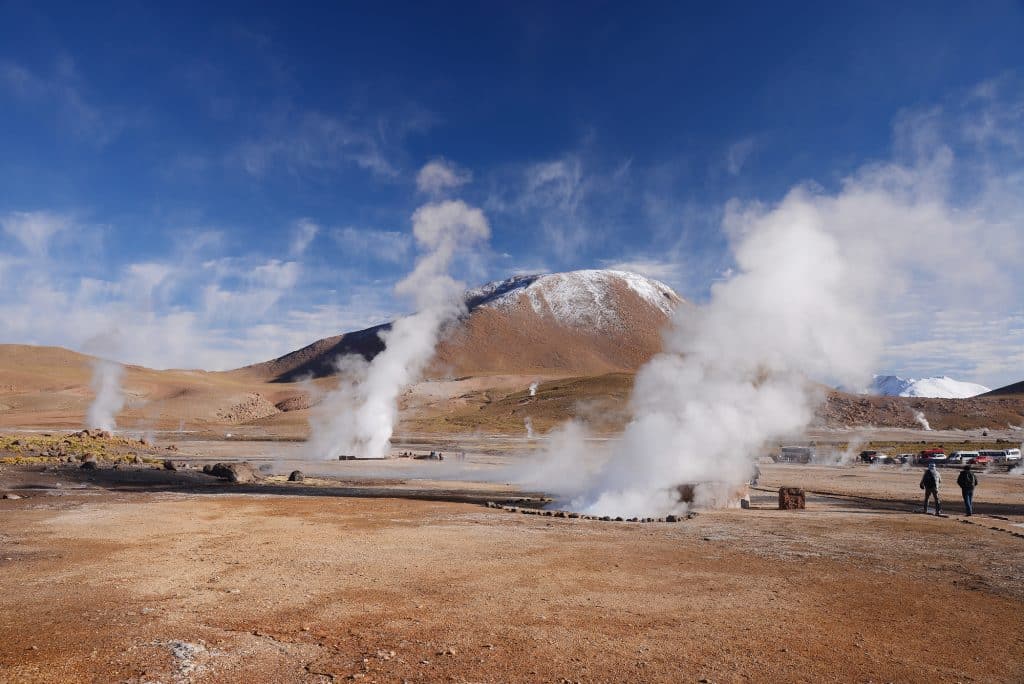
See El Tatio Geysers at dawn
Situated at a sky-high 4,300 meters, El Tatio is the highest geyser field in the world. These 80 hot water and stream eruptions reach heights of 10 meters. But if you want to see the bubbling explosions in action for yourself, you’ll need to visit VERY early in the morning — just before sunrise.
Yes, that means you’ll need to leave San Pedro de Atacama at about 4:00 AM to get there on time. For this reason, I strongly recommend visiting on a tour rather than driving there on your own. The roads are not in great condition and you don’t want to be driving them in the dark — plus the altitude here can lead to headaches and nausea.
Instead, I recommend booking this tour to the El Tatio geysers, on a bus with big windows. You’ll be picked up around 4:00 AM and can snooze the whole drive there. You’ll visit the village of Machuca and the Rio Putana wetlands afterwards.
You should also know that it’s extremely cold at the El Tatio geysers before the sun comes up — below freezing. Wear all of your warmest clothes. It will get better once the sun comes up.
Still intent on driving yourself? Some visitors to San Pedro de Atacama wait for an excursion van and tailgate them all the way to the geysers. Drivers hate this, but it will help you see where you’re going. Allow two hours for the drive (90 minutes if you have a 4X4). But if you’re on your own, you can visit the Puritama Hot Springs on the way back (more on that below).
The entrance fee at the El Tatio geysers is 15,000 CLP ($16 USD) in cash and must be paid by all visitors, regardless of tour.
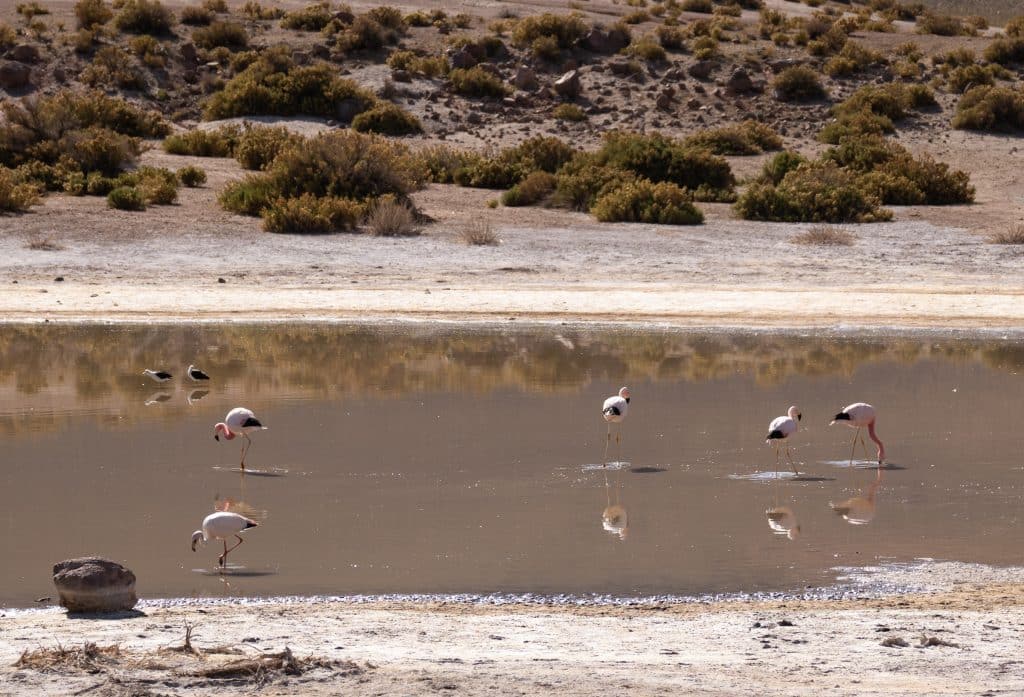
Stop off at Lagunas Flamingos
The Lagunas Flamingos are located just south of Mahuca, on the way back from El Tatio. These lakes are named for the cotton candy-colored birds who wade in the shallows – go figure!
It’s worth stopping for a few photos on the way back from El Tatio Geysers. However, I don’t think it’s worth making a special trip to these lakes. Stick to the Puritama Hot Springs instead. Which brings us to our next item…
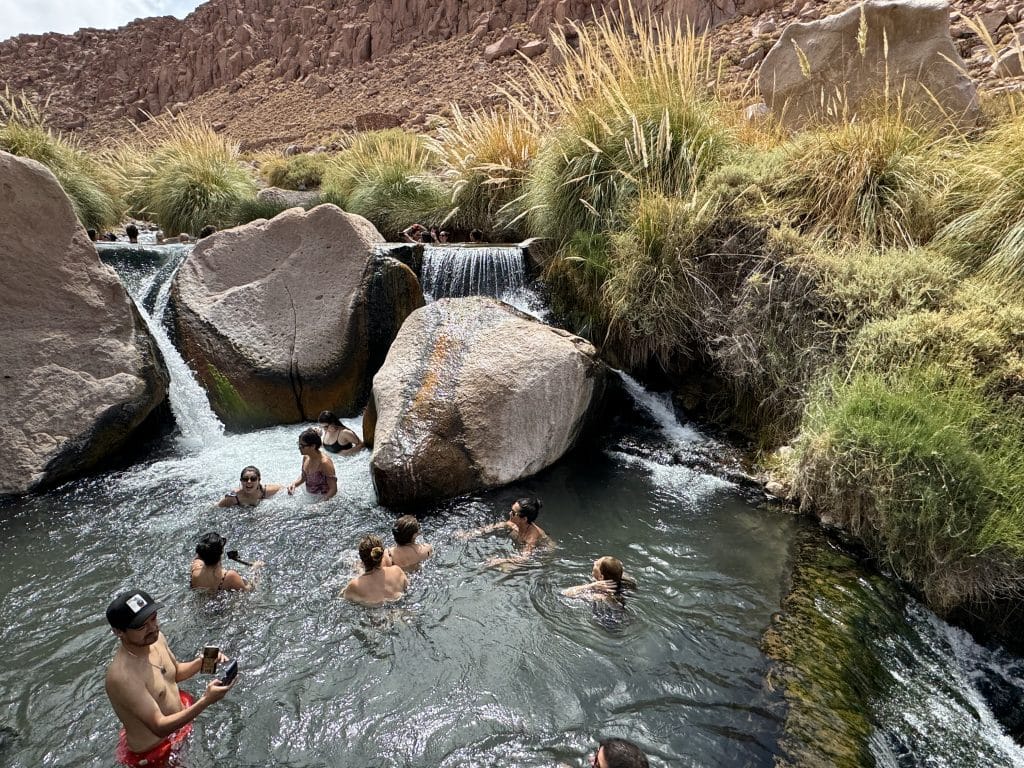
Soak in the Puritama Hot Springs (Termas de Puritama)
Now THIS was my favorite experience in the Atacama Desert! I love visiting hot springs around the world, from Iceland to Italy, but the Puritama Hot Springs might have the most unique setting of all: a verdant canyon in the middle of the desert.
It looks like nothing when you arrive — just a parking lot. But hidden from the road is a pathway that slowly descends into the canyon.
Here you can enjoy a chain of seven pools, all of them linked with waterfalls. The water is warm, not hot, but these pools are absolute PARADISE after spending a few days in the driest place in the world!
There are restrooms and single-sex group changing rooms (no private stalls) at the complex. You’ll need to bring your own lock if you want to use the lockers, and there is no food or drink. I recommend bringing flip-flops for walking the paths between the pools, and take it slowly on the walk out of the canyon — the high altitude makes uphill climbs extra challenging!
It takes 30 minutes to drive to the Puritama Hot Springs from San Pedro. Without a car, you can book this tour to take you.
Tickets cost 35,000 CLP ($38.50 USD) per adult and must be purchased online in advance for either the morning, afternoon, or sunset slot. (Note that there are mid-day closures between the time slots.) Even if you book a tour, you still need to buy admission via this website.
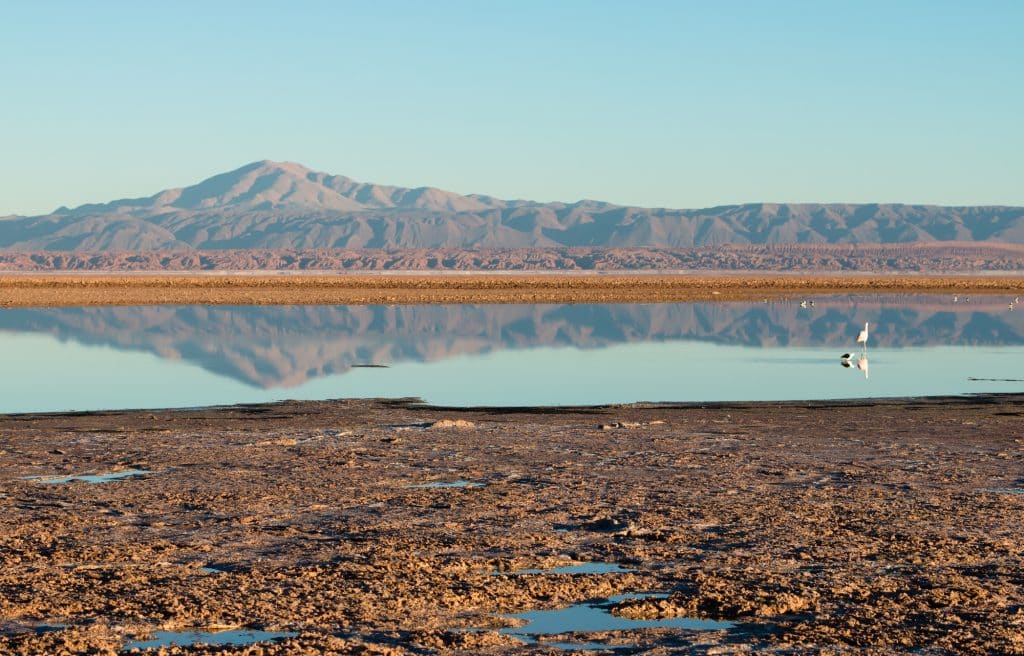
Find flamingos at Laguna Chaxa
Laguna Chaxa is one of the best spots on the Atacama salt flats for seeing flamingos. This shallow lake is the habitat of Chilean, Andean, and James flamingoes.
It takes 1 hour and 40 minutes to drive to the Chaxa Lagoon from San Pedro. Once you leave the main road it switches to gravel, like many of the roads in the region, but it is drivable in a regular car.
I think Laguna Chaxa is best visited on the way back from Lagunas Altiplánicas and Piedras Rojas, as it’s an easy detour from that main road. This Atacama Salt Flat and Piedras Rojas tour is a full day out and stops at all three.
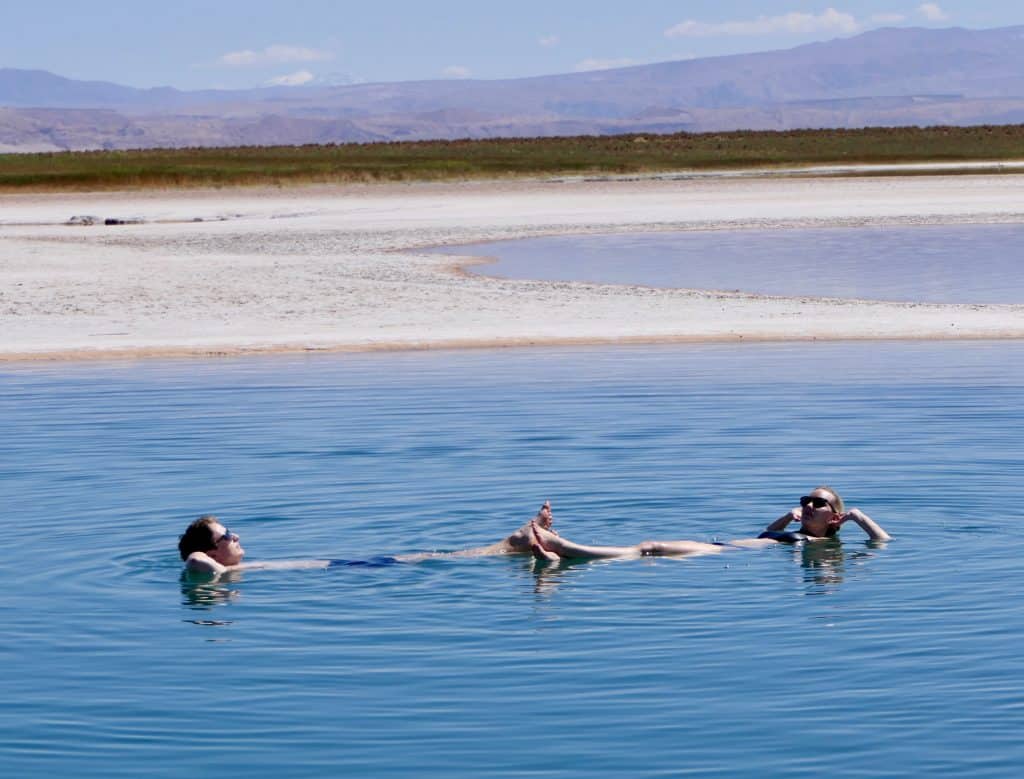
Float in salty Laguna Cejar
Laguna Cejar is another part of the Atacama salt flats where you’ll see flamingos. Plus, you’ll have the chance to float in the saline-loaded waters — this lake is saltier than the Dead Sea!
Cejar Lagoon is the first stop on the short walking path. However, the lake you’ll actually swim in is Laguna Piedra. (Pretty much all locals refer to both lakes as Laguna Cejar, which can be a bit confusing.)
It’s cold when you first enter the water, but you’ll soon warm up. Swimming is capped at 20 minutes for safety reasons, after which you’ll need to shower the salt off before leaving.
Lagunas Cejar and Piedra are an easy 25-minute drive from San Pedro. You can buy an entry ticket for 20,000 CLP ($22 USD) online.
But like all things in this part of the world, random closures can happen. Unfortunately Laguna Cejar happened to be closed when Charlie and I showed up. Oh well — next time!
Want to do it on a tour? This top-rated tour to Laguna Cejar, Ojos del Salar, and Laguna Tebinquinche is available. Admission to the lagoons is payable in cash to the guide, and the outing includes a picnic.
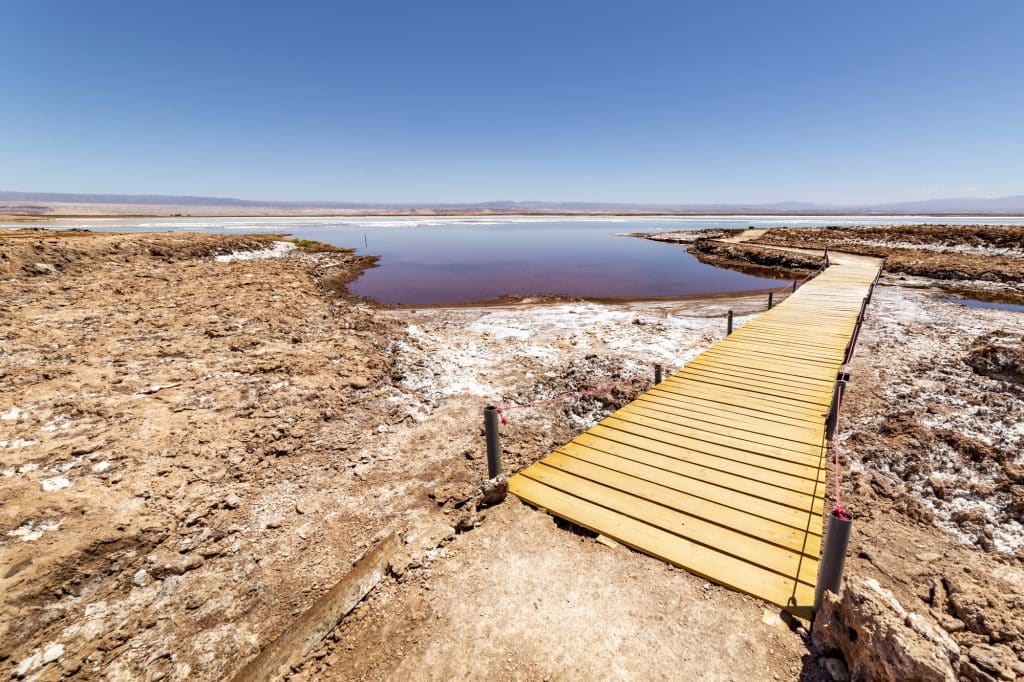
Catch sunset at Laguna Tebinquinche
The Atacama Desert is fascinating from a biological perspective — and Laguna Tebinquinche contains a unique microbial ecosystem that isn’t found anywhere else on the planet. And it’s another visually spellbinding destination.
Touching the water and salt deposits is forbidden, but you can enjoy views of the layers from the footpath. Tourists must leave before sunset, but you should stay as long as possible to enjoy the glorious light and color changes.
It’s a 20-minute drive from Laguna Cejar with a stop at the two sinkholes known as Ojos del Salar (Eyes of the Salt Flats). The aforementioned tour to Laguna Cejar finishes off at Laguna Tebinquinche.
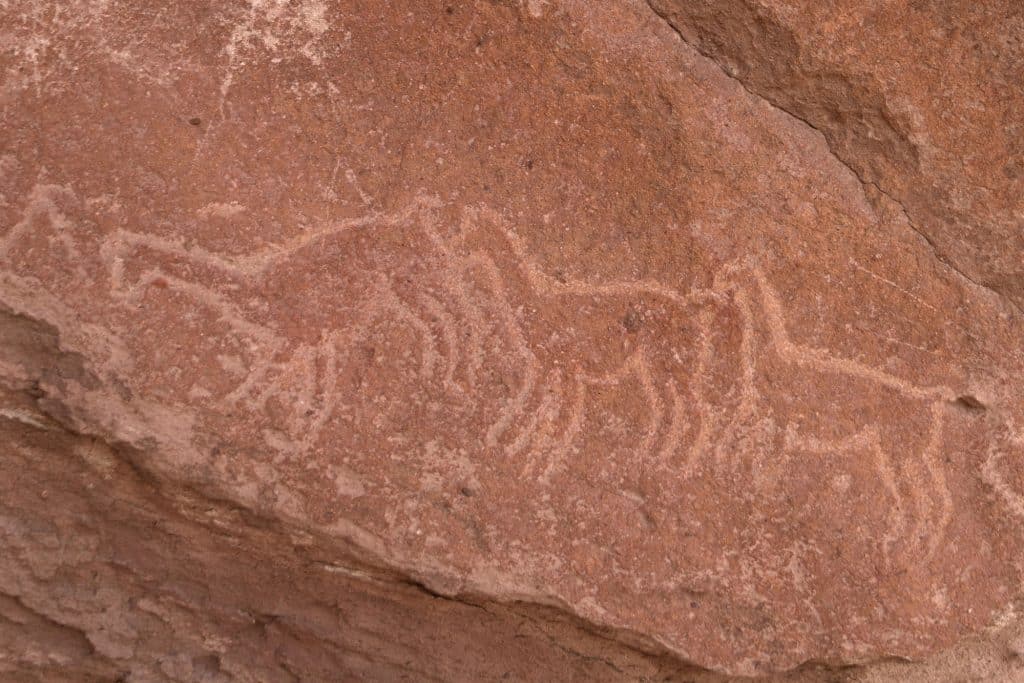
Check out the Yerbas Buenas petroglyphs
Yerbas Buenas is a great place to learn about the human history of San Pedro and the surrounding area. This area is rich with petroglyphs from 10,000 years ago.
This rock art depicts animals of the Atacama, including vicuñas and Andean foxes.
It’s a 50-minute drive from San Pedro de Atacama to the Yerbas Buenas petroglyph. This six-hour tour to Valle del Arcoíris, the Atacama’s Rainbow Valley, includes a stop on the way back. And like any place featuring ancient art, it’s good to have a guide explain it to you.
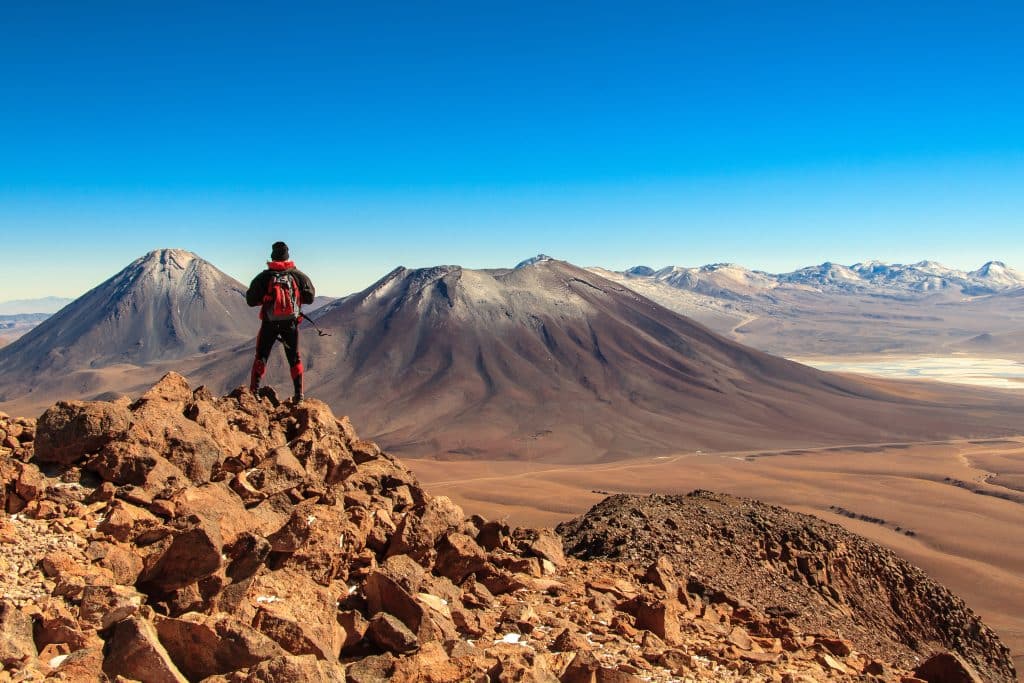
Climb Cerro Toco
If you’re physically fit, acclimated to the altitude, and up for a challenge, climbing a dormant volcano in the Andes mountains is one of the most adventurous things to do in San Pedro de Atacama.
Cerro Toco reaches 5,604 meters and is one of the top places for spectacular desert views (in a region that seems to have spectacular views around every corner!).
You’ll need to book a guided Cerro Toco summit trek with a certificated high-mountain guide. Proper trekking gear is mandatory, and keep in mind that the high altitude makes this far more difficult than if it were at a lower elevation. Do not even think of doing this if you’re not accustomed to hiking in altitude.
Visit Museo de Meteorito
Inspecting meteorites collected from the desert is one of the most unexpected things to do in San Pedro de Atacama in the evening before dinner. Museo de Meteorito contains achondrites, chondrites, mesosiderites, and pallasites.
An audio tour is available in multiple languages. At the end, you’ll have a hands-on demo for detecting meteorites from regular rocks.
The Meteorite Museum is open Tuesday through Sunday, 6:00-9:00 PM. Cash-only admission is 5,000 CLP ($5.50 USD).
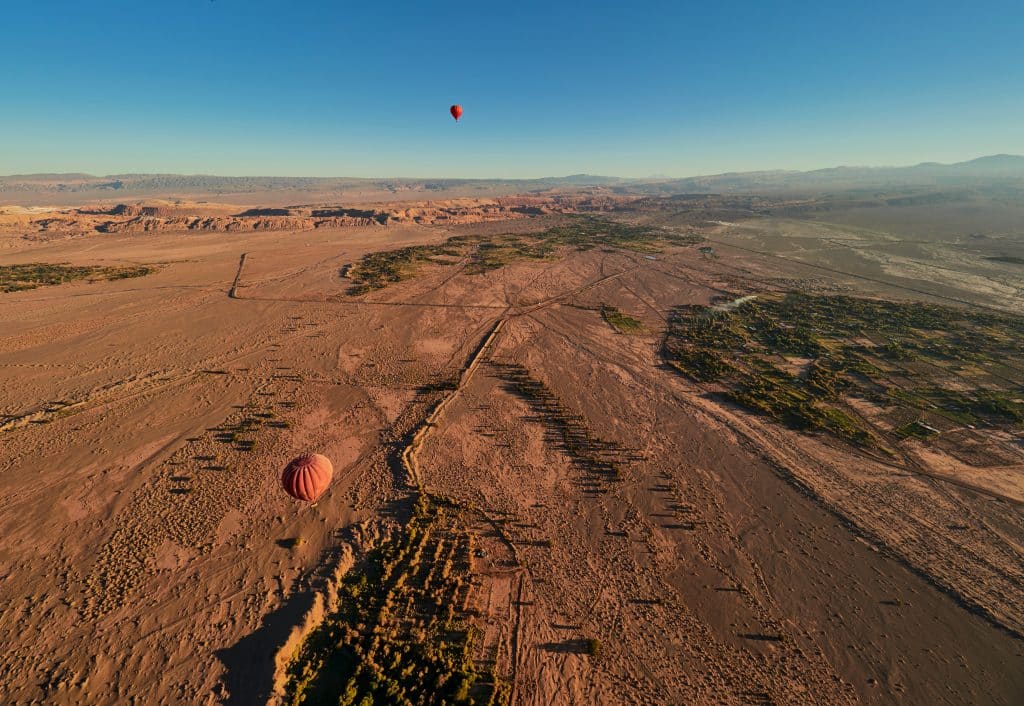
Ride a Hot Air Balloon
Are you a baller? You can’t get much more baller than riding a hot air balloon over the Atacama Desert! And it’s hard to imagine a better view than from the sky.
Yes, it’s expensive — but I would file this under “once in a lifetime” travel experiences.
You can find and book hot air balloon flights in San Pedro de Atacama here, and they take place in the early morning between September and May.
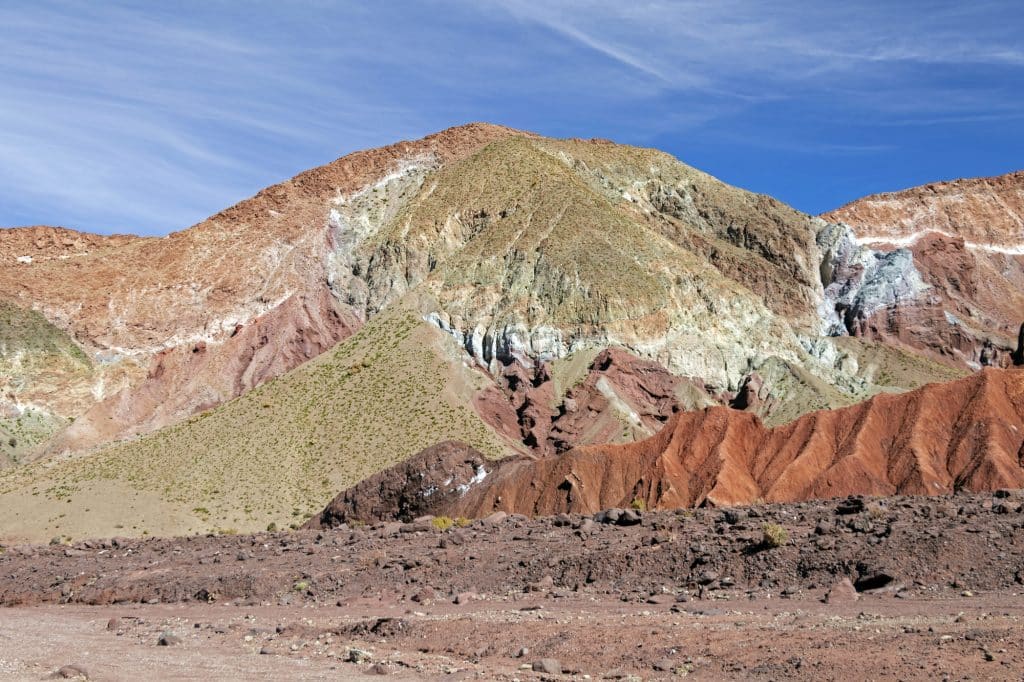
Off the Beaten Path near San Pedro de Atacama
Here are a few more destinations in San Pedro de Atacama worth visiting:
Salar de Tara — Located within the Los Flamencos National Reserve in Northern Chile, this phenomenal salt flat borders both Bolivia and Argentina. Besides flamingoes, you’ll see sand-carved “cathedrals.”
Laguna Baltinache — More salty lakes, you say? Why not! Not a lot of people visit the Hidden Lagoons of Baltinache, preferring Lagunas Cejar and Piedra, which makes them a lovely escape.. Swimming is permitted in two of the seven.
Valle del Arcoíris — The Atacama’s “Rainbow Valley” contains stripey mountains and rock formations formed by wind erosion. It’s the first stop on this six-hour tour to Valle del Arcoíris followed by Yerbas Buenas.
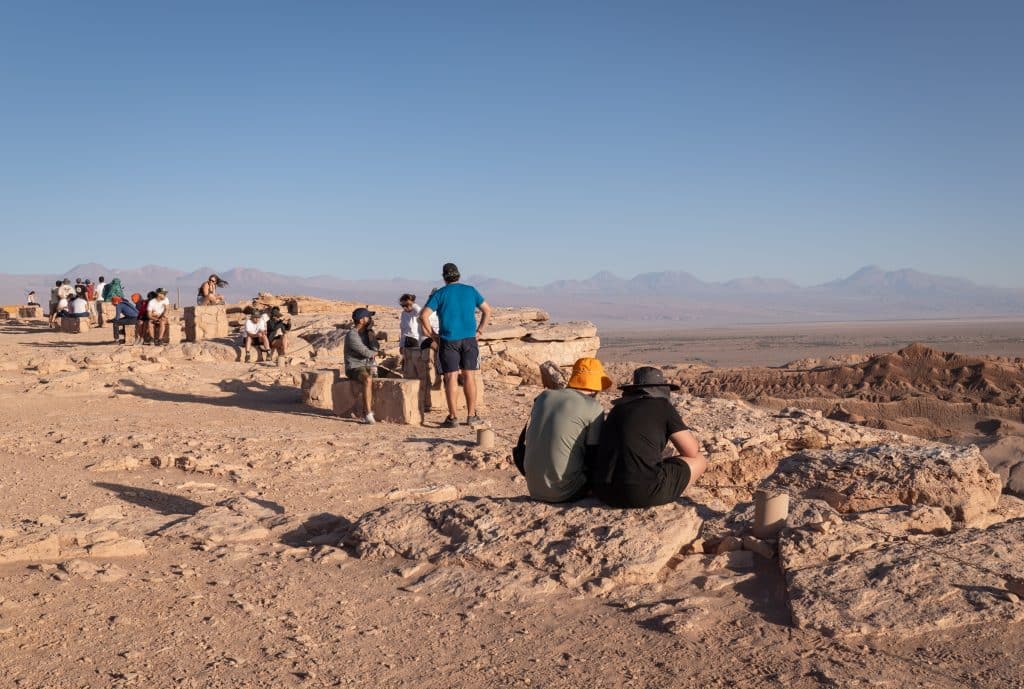
How Much Time to Spend in San Pedro de Atacama
I think three days in San Pedro de Atacama is the perfect amount of time. If you arrive midday on the first day, that’s fine — you still have time for the Valle de la Luna, sunset at La Piedra del Coyote, and even some stargazing.
A four- or five-day itinerary would give you enough time to do everything on this list.
There are a few points of consideration into how many days to spend in San Pedro de Atacama. First of all, it’s in the middle of nowhere, so you’ll probably have to plan flights on either side, and second, the high-altitude desert environment can be tough to get used to.
Be sure to take it easy and slowly increase your elevation. Most guides recommend starting easily with the Valle de la Luna and saving El Tatio geysers for your last day because it’s at a much higher altitude.
Finally — thanks to our crusty noses, dry lips, and a few headaches, Charlie and I were relieved to leave the desert after three days. Our next destination was Puerto Varas in the lush, green Los Lagos region and it felt like paradise!
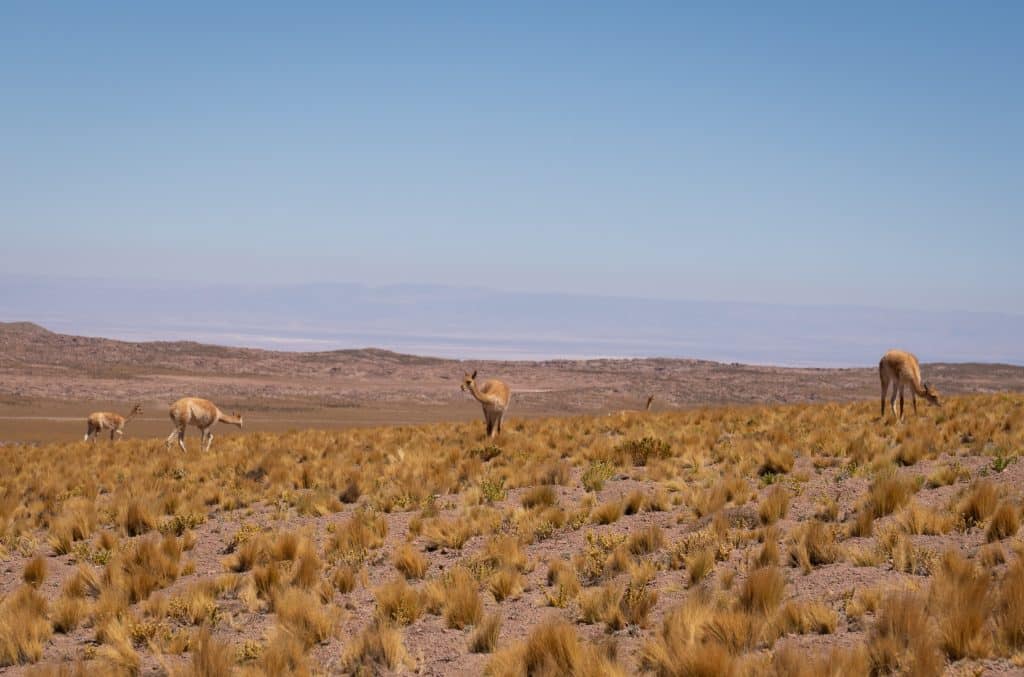
How to get to San Pedro de Atacama
The closest airport to San Pedro de Atacama is in the city of Calama. El Loa Airport in Calama has several flights to Santiago each day, which take about two hours. From Calama it’s a one-hour drive to San Pedro.
There are several kiosks at the arrivals terminal selling bus transfers to San Pedro. A single fare is 15,000 CLP ($16.50 USD). If you’re traveling during the peak travel months (November through March), I recommend you pre-book a shared transfer.
You can also rent a car in Calama and drive to San Pedro de Atacama, as we did.
Not up for flying? There is a bus to San Pedro de Atacama from Santiago, but it takes a whopping 22 hours! Chile is a looooong country.
You can also look at traveling to or from San Pedro by bus from other South American destinations. Tours of the Salar de Uyuni in Bolivia often finish in San Pedro de Atacama, and there are buses from the city of Salta, Argentina, that take 10 hours.
Recorrido and Busbud are the best places to scope out routes and fares.
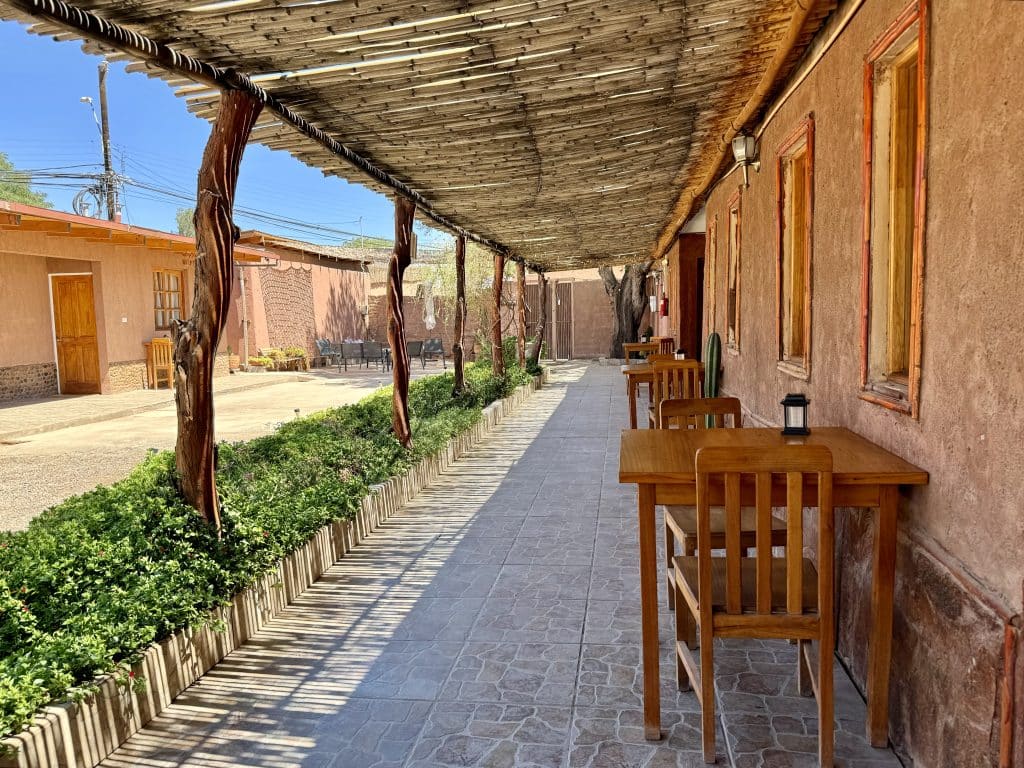
Where to Stay in San Pedro de Atacama
San Pedro de Atacama is a relatively small town. I recommend staying close to Caracoles, the main walking street in town, which is home to lots of restaurants, shops, bars, and tour companies. Everything is close by when you stay near Caracoles.
For that reason, I selected the top-rated hotels in San Pedro that are close to Caracoles:
Top-Rated Luxury Hotel in San Pedro de Atacama: If you’re happy to splash out, you’ll appreciate the exceptional Hotel Desertica for its pool. Abode rooms are tricked out with natural materials and have swanky private bathrooms.
Top-Rated Mid-range Hotel in San Pedro de Atacama: Casa Lickana B&B is where I stayed and I’m happy to recommend it based on location, security, and value for money! The rooms aren’t huge, but they have private outdoor patios, and breakfast is included (including hot dishes like scrambled eggs). The staff are lovely and kind, though you shouldn’t expect any of them to know any English (which is not unusual in Chile).
Top-Rated Budget Hotel in San Pedro de Atacama: La Casa del Pueblo Hostal is a fuss-free budget option that offers economical double rooms and family rooms with either a private or shared bathroom. Breakfast is included in the price and rental bikes are available.
Find deals on places to stay in San Pedro de Atacama here.
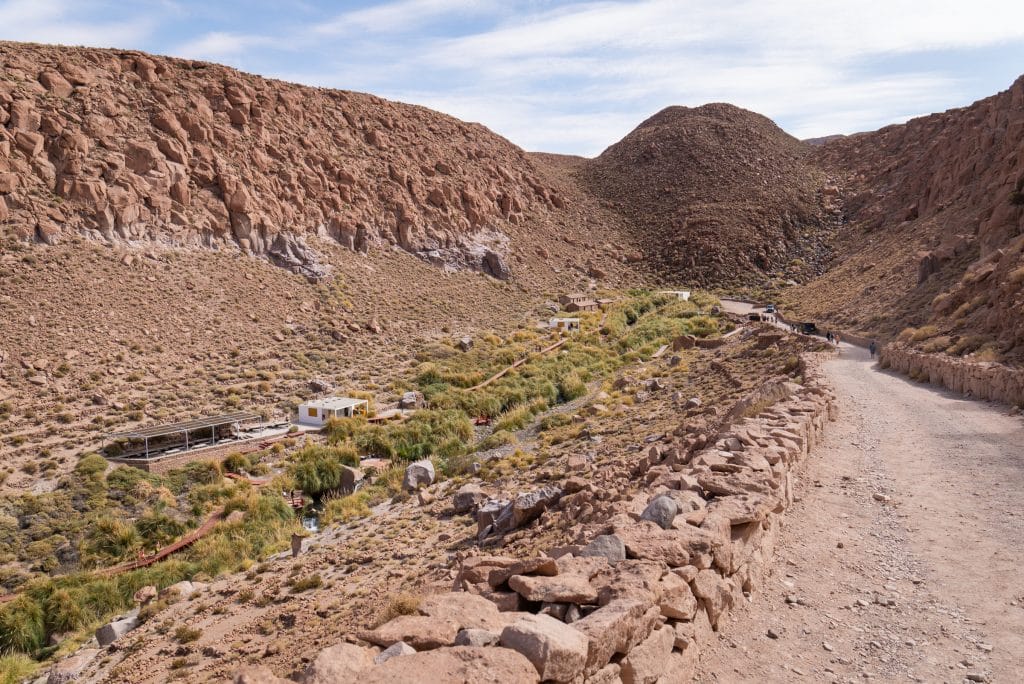
Best Time to Visit San Pedro de Atacama
It’s possible to visit San Pedro at any time of year. It’s warmest during summer: that’s December, January, and February in the southern hemisphere! October, November, and March are best for decent weather, fewer crowds, and lower accommodation rates.
A very short but pretty intense rainy season occurs in February. It brings a heavy onset of rainfall for a week or so near town. However, most parts of the Atacama have never seen a drop of rain. (EVER! Seriously! How does life exist here?!)
The winter months of June, July, and August are bone-chillingly cold at night, although they have the perk of clear skies and minimal crowds. This is also when you can see the Milky Way in the Atacama Desert.
Mornings, evenings, and nights in the Atacama are always cold, but temperatures in San Pedro are blisteringly hot during the early afternoon. Certain tourist spots are subject to colder/windier daytime conditions at all times of the year, like El Tatio before dawn, where temperatures are often below freezing. Bundle up!
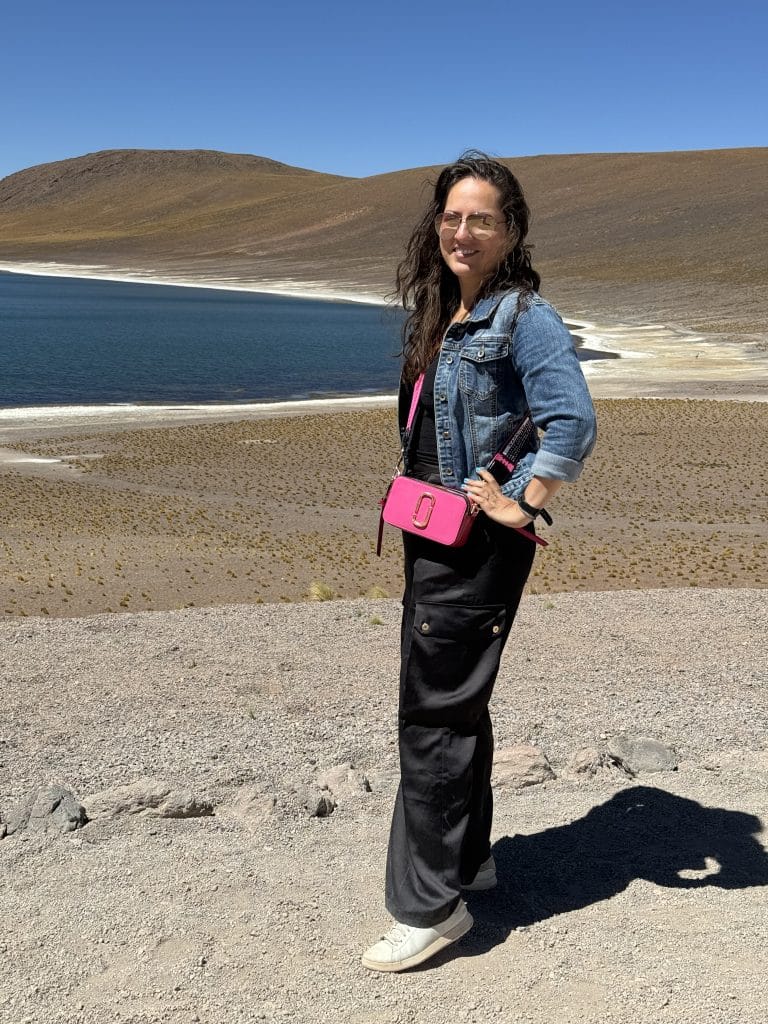
Is San Pedro de Atacama Worth It?
Okay, I’ll be honest with you — San Pedro de Atacama was worth it for me personally, but I don’t think it’s for everyone. The environment is visually spectacular, but visiting this area involves a lot of long distance drives on rough roads to “just look at things,” as my husband put it.
The Puritama Hot Springs and stargazing tour were much more interactive, but he was right — besides those things, there was a lot of “drive two hours to a thing, take a photo, and there’s nothing else to do there, so you leave.” That, on top of the dryness, peeling lips, and altitude fatigue.
San Pedro is quite a far distance from everything else in Chile, so if you’re not 100% set on visiting, you may want to consider whether your limited time in Chile would be better spent hiking in Patagonia, exploring towns in the Lakes region, or enjoying art and culture in Valparaíso.
But if you love deserts, unusual landscapes, photography, and star-gazing, I think you’ll love the Atacama! This truly is a special part of the world, and I’m so glad I got to experience it.
More on Chile:
- Staying at Ecocamp Patagonia: A Sustainable Resort in Chile
- 17 Best Things to Do in Santiago, Chile
- 15 Best Things to Do in Puerto Varas, Chile
- 11 Cool Day Trips from Santiago, Chile
- 17 Colorful Things to Do in Valparaíso, Chile
More on South America:
- Solo Female Travel in Colombia: Is it safe?
- What’s it really like to travel to Guyana?
- 16 Epic Things to Do in Ushuaia, Argentina
- 25 Epic Things To Do in El Calafate, Argentina
- 18 Wild Things to Do in El Chaltén, Argentina
- El Calafate vs. El Chaltén: Which Town in Argentine Patagonia Better?
- 32+ Fun Things To Do in Buenos Aires, Argentina
Have you been to San Pedro de Atacama? Share away!